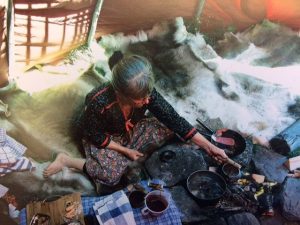Listeners to Radio 4’s Food Programme will have head the fascinating account of the Hadza, East Africa’s last group of hunter gatherers with a diet of 95% wild food and an extraordinarily rich microbial gut flora (https://www.wired.com/2014/04/hadza-hunter-gatherer-gut-microbiome/). The hypothesis tested in the programme is that in the transition from hunter gatherer to settled modern life we have lost much of the microbial diversity that kept us healthy. This is another good example of the relationship between diversity and resilience which is at the core of so much in life.
Europe’s equivalent to the Hadza are the Sami people of Northern Scandinavia. Like the Hadza they are an indigenous community who have a proud tradition stretching back millennia and like the Hadza they may have a knowledge of utilizing edible wild plants and animals that may help us adapt our lifestyles to meet the challenges in a changing environment.
Two years ago RBGE and Scotland’s Natural Larder hosted a small group of Sami people led by the cook, café manager and cultural ambassador Greta Huuva. I never had the pleasure of eating at the Viddernas Sami restaurant in Jokkmokk but Greta’s experience and enthusiasm for the diverse range of wild foods found in the Far North of Europe tells me it must be a special culinary experience.
Edible biodiversity for Greva included a multitude of uses for plants like Angelica archangelica (a garden plant in Scotland) and roseroot Rhodiola rosea (which occurs as a wild plant in Caithness) not to mention 101 delicacies you can extract from a butchered reindeer carcass!
Like all good ambassadors who travel widely to share their knowledge Greta Huuva was also curious about the people and places she visited. When she came to Scotland she was keen to learn from our wild food enthusiasts meeting and sharing information with forages like Monica Wild, Mark Williams and Buck and Birch, as well as my crofter friends Lesley and Thomas Kilbride of Applecross. I remember the delight in her eyes when we found chaga (Inonotus sp.) mushrooms growing on a birch tree on Speyside and how keen she was to exchange knowledge of this valuable medicinal fungi.
Like the Hadza the Sami culture faces the threat of assimilation from mainstream society from outside their homeland. With her university education Greta could have chosen to work anywhere in Europe but she remained in Sami lands and opened a café to provide Sami, Swedes and tourists with a warm hospitality that demonstrated the unique nature of traditional Sami home-cooked fish, meat and vegetable dishes. But she wasn’t afraid to adapt “…we have to dare to offer outsiders Sami food … but I also want to make them curious and bold and be prepared to try cooking food based on their own ideas, using their head, trusting their own sense of taste and feel.”
It was a privilege to have known Greta and on learning of her recent death I pass on my sincere sympathy to her husband Anders Hakansson and daughter Linn. Anders and Linn accompanied Greta on her 2015 Scottish tour and Linn continues to manage Viddernas in Jokkmokk.

